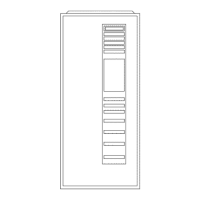PRESSL RE SWITCH Tt BING
One collector box pressure tube (pink label) is fi_ctory cormected to
the pressure switch for use when J::urnace is installed in L PFLOW
applications This robe MLST be disconnected and used for the
condensate trap relief port robe. The other collector box pressure
robe (green label) which was fi_ctory connected to the condensate
trap relief port connection MUST be connected to the pressure
switch in DOWNFLOW or HORIZONTAL R1GHT applications
NOTE: See Fig. 12 or tube routing tahel on main fl/rnace door to
check for proper connections
Relocate tubes as described below:
1. Disconnect collector box pressure tube (pink label) attached to
pressure switch.
2. Extend collector box pressure tube (green label) which was
previously connected to condensate trap relief port com_ection
by splicing to small diameter robe (factoQ'-supplied in loose
parts bag).
3. Route extended collector box pressure robe behind inducer
motor bracket then between inducer motor and pressure
switch.
4. Connect collector box pressure tube (green label) to pressure
switch connection labeled COLLE(TOR BOX.
5. Use remaining smaller diameter tube (fitctory-supplied in
loose parts bag) to extend collector box pressure robe (pink
label) which was previously connected to pressure switch.
6. Route this extended tube (pink label) to condensate trap relief
port connection.
7. Detem_ine appropriate length, cut, and connect robe.
8. (lamp robe to relief port connection.
CONDENSATE TRAP FREEZE PROTECTION
Refer to Condensate Drain Protection section for recommendao
tions and procedures.
CONSTRU(T A WORKING PLATFORM
Constnlct working platfbm_ where all required Nmace clearances
are met. (See Fig. 3 and 11.)
[TNIT MAY NOT OPERATE
Failure to %llow this caution may result in intem_ittent unit
operation.
The condensate trap MUST be installed below fire, ace See
Fig 5 tbr dimensions, The drain connection to condensate
trap must also be properly sloped to an open &ain
NOTE: Combustion-air and vent pipes are restricted to a mini°
mum length of 5 fi. (See Table 7.)
NOTE: A 12-in. minimun_ offset pipe section is recommended
with short (5 to 8 ft) vent systems. This recommendation is to
reduce excessive condensate &oplets fi'om exiting the vent pipe.
(See Fig. 11 or 34.)
UPFLOW OR DOWNFLOW
V2" MAX
HORIZONTAL
A02146
Fig. 13--Furnace Location for Proper Condensate
Drainage
LOCATION
Step l--General
This furnace must
* be installed so the electrical components are protected from
water.
not be installed directly on any combustible material other than
wood flooring (refkr to SAFETY CONSIDERATIONS).
* be located so combustion-air and vent pipe maximum lengths
are not exceeded. Refkr to Table 7
* be located where available eteca'ic power and gas supplies meet
specifications on the furnace rating plate
* be attached to an air distribution system and be located as close
to the center of the distribution system as possible Re['cr to Air
Ducts section
* be provided with ample space fi_r servicing and cleaning.
Always comply with minimum fire protection clearances
shown on the Nrnace clearance to combustibles label.
NOTE: For upflowidownflow applications install fiu'nace so that
it is level or pitched fbnvard within 1/2-in. for proper hmaace
operation. For horizontal applications pitch 1/4-in. minimum to
li2-in, maximum forward to ensure proper condensate &ainage
from secondaw heat exchangers. (See Fig. 13.)
When a furnace is installed so that supply ducts car_- air circulated
by the fllmace to areas outside the space containing the furnace.
the return air shall also be handled by duct(s) sealed to filmace
casing and terminating outside tl_e space containing the fitrnace to
ensure there will not be a negative pressure condition within
equipment room or space.
This Nrnace may be located in a confined space without special
provisions for dilution or ventilation air.
13

